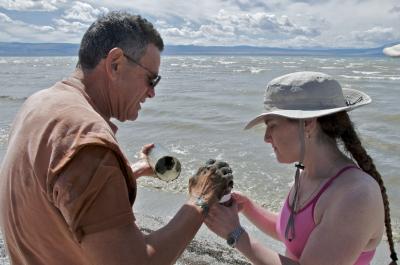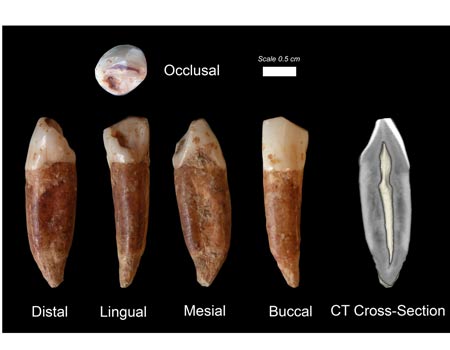The factor that is revealed in its hiddenness is the press, which is often completely incapable of dealing with scientific issues in a professional manner.

by Eitan Crane
At the end of December, news spread in the media about a sensational discovery in a cave near Rosh Ha'Ain: researchers from Tel Aviv University allegedly discovered evidence that modern man lived in a cave about 400 years ago, long before the time when, according to popular opinion, our ancestors were supposed to have left Africa.
A few weeks ago, the media reported on another sensational discovery: researchers allegedly discovered bacteria with different biochemical mechanisms than the known one, and the difference was so great that there were journalists who claimed that these were aliens or at least an alternative life form.
The word that connects the two stories is the word "allegedly", and in both cases it highlighted a new order in scientific communication whose protagonists are scientist bloggers.
At the beginning of December, we brought here, on this blog, the story of Felice Wolf-Simon and her colleagues, who discovered evidence that bacteria from Lake Mono in California are able to incorporate atoms of the element arsenic in their biochemical processes instead of nitrogen and even incorporate them into DNA. The researchers sent the article to the very prestigious journal SCIENCE, where it was published after peer review.
If things continued as they usually do in science, fellow scientists (or rivals) would check the article and respond to it in the usual ways: a lecture at a scientific conference, a response letter to the editors, and of course through additional studies that would confirm or contradict the conclusions; The results of these studies would be published in scientific journals.
The quality control, starting from the original article, up to the response articles, was conducted in the old and familiar way by research colleagues, usually anonymous, in a method known as "peer review" - this is how it usually happens.

But Wolf-Simon's discovery is an extraordinary discovery, and Felisa Wolf-Simon works at an agency with extraordinary media power. Therefore, the researcher and her host institution were not satisfied with publication in the scientific press, but held a well-publicized press conference. Under the title "Discoveries that have implications for the study of life in space". NASA did indeed bring another scientist to the press conference, a renowned organic chemist, Steve Benner, who is also a researcher at the same institution where Wolff-Simon is researching. Banner expressed reservations, but his caution was almost completely ignored. All the media went out of their way with excitement.
Tel Aviv University was also not satisfied with the article by its researchers Prof. Avi Gofar and Dr. Ran Barkai from the Department of Archaeology, who are managing the excavation at Kesem Cave, and Prof. Israel Hershkowitz from the Department of Anatomy and Anthropology at the Sklar School of Medicine at Tel Aviv University (who worked in collaboration with an international team of scientists) and issued, as usual, a press release with the title: "Evidence of the presence of a modern man (Homo Sapiens) in the Land of Israel already about 400 years ago was discovered." The message went on to say that "this is the earliest period in which evidence of the existence of modern man has been found so far in the world."
Let's stop here and think for a moment what would political journalists do if they received a press release of this type, which was sent to them from the Prime Minister's office, for example? Or what would economic journalists do if a large corporation made a sensational announcement that might change our economic reality?
But it turns out that when it comes to scientific news, most of the journalists who cover the scientific field in the general press did not bother to read the original articles and certainly did not do so with a critical eye that allowed them to ask some difficult questions of Felisa Wolf-Simon or the researchers from Tel Aviv University - as requested. The news spread around the world therefore reflected the content spread by the public relations mechanisms.
A few days after the sensational publications it became clear that the dramatic news in both cases was exaggerated. In the case of Felice Wolf-Simon, serious deficiencies in her methodology were discovered. And in the case of the Israeli researchers, it turned out that their working methods and the article itself are probably flawless, but the article itself has no trace of the unequivocal claim emerging from the press release. It is important to add that in the interview Prof. Gopher gave to the journal Nature, he backed up the press release of the university spokeswoman's office, saying that although it is worded more "sharply" than the original article, it is not wrong, because it describes one of the possibilities that the article raises.
The important point for our case is that in both cases it was not the press that exposed the problematic points in the reports, but rather other fellow scientists who run blogs on the Internet. Rosie Redfield of the University of British Columbia sharply attacked Wolff-Simon's paper, and Carl Zimmer and Brian Switek questioned the reports from Magic Cave. Moreover, after Wolfe-Simon tried to take cover by claiming that she would only respond in the usual channels (ie in peer-reviewed articles), she realized how ridiculous this was after the dramatic press conference and began to conduct a public dialogue with Redfield in the blogosphere, including through her own blog. The uproar over the article also required a temporary change in Science journal policy and allowed free access to the article for a month (which usually requires very high subscription fees, or a one-time payment of $20 to $40 per article).
The two examples show a change that is taking place in the way the scientific media works, and raises a very serious doubt about the professionalism and reliability of the "regular" newspapers in everything related to science. The journal Nature even devoted its editorial to the issue in the issue of December 16 (before the Rosh Ha'Ain affair), calling on scientists to adjust their way of thinking, to accept these new forms of scientific responses and discussion. Nature editors encourage scientists to respond to criticism directed at them on the Internet and not to wait for official publications. Because if not, the editors warn, they will be forced to experience some of the hard truths related to the speed with which digital criticism spreads.
Publication after peer review is one of the most effective ways to maintain the quality of scientific information and promote science, but it is not the only way, nor is it without problems. At the moment it is also still the only legitimate road to advertising. Scientific blogs are few and far between, and only a few notable articles receive attention in the blogosphere - but even fewer do the articles in the blogs receive a reaction from the scientists themselves.
Both stories bring up several lessons:
Scientists can only stay behind the public relations wall of their institutions as long as their research does not attract attention - once the article is important, they are in the media's line of fire, and it is highly desirable that they know how to deal with the consequences and the criticism.
The public relations systems of the research institutions need to be more careful: the journalists may accept everything they publish, but also other scientists, sometimes rivals, now have the means to answer immediately. At the moment their voice may be weak, but it is getting stronger, and the damage they are able to cause when they spot a mistake, may be greater than the flashy headline - and the damage is serious to the researchers themselves and to science in general.
And in my humble opinion, the factor that reveals itself in its hiddenness is the press, which is often not at all capable of dealing with scientific issues in a professional manner. This is the most serious lesson of all, because it turns out that right now, in an era where scientific research may have far-reaching consequences on our lives - and when this is related to reports on global warming or new drugs - we have no reason to trust our daily newspaper.

6 תגובות
All because of money and publicity, a lot of noise around "discoveries" creates publicity, publicity brings donors to the academic institutions which these days need every dime like air to breathe.
I suggest to the editors of the non-scientific papers, to carefully check new discoveries,
And I will be with scientists,
Or at least with serious scientific journals,
before their publication,
Because, it's a shame to write untested things,
which destroys the credibility of the reports as a whole.
Thanks
Peace
Anat:
And what did you want?
what would you do
Yehuda:
You can say what you want, but those who want to be respected are satisfied with saying the right things.
The scientific establishment was not revealed in its darkness but in all its glory when the published news was brought into the appropriate proportion.
The fact that scientist X or the institution where he works is hasty in publishing - it is unpleasant, but it is a human trait and not a trait of an institution.
The scientific establishment is structured in such a way that this type of error will be corrected.
What's more - as explained in the article - at least in one case - the professional article did not contain the claims published in the media at all.
Bet-ya:
Journalists will not fall into this trap if they make sure to publish only what has been published in professional scientific journalism.
mr crane,
What do you want from the journalists? Their job is to report. And they report what they hear or see. The responsibility for the report lies with the scientists and the academic institutions, who unfortunately today are looking for quick, cheap, and flashy publicity, because according to them, those who are more famous get priority in giving research grants. And there are no shortage of those whose research is trending, and is intended to serve interested bodies.
To Ethan Crane
And maybe we will have to treat your article in the same way. Why say "the factor that is revealed in his nakedness is the press" and not say the source of the information - the scientific institution, was revealed in his nakedness. What is this similar to?, feeding someone spoiled food and then blaming him for not digesting it properly. The one who is to blame is the feeder and not the consumer who eats!
What requires the main correction is the source of the information - the scientific bodies, and not the consumer of the science - the press, which in the end knew how to correct itself and force corrections from the source.
That's my opinion
Good Day
Sabdarmish Yehuda
In science, you published a week ago that they found bacteria of alien origin
And now an article about posting nonsense